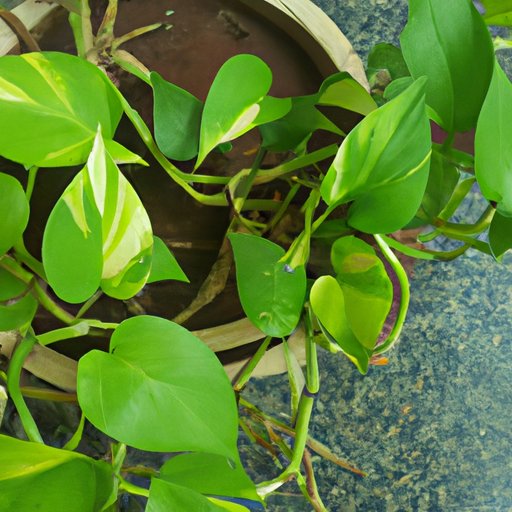
Introduction
Money plants, also known as Pothos, Devil’s Ivy, or Epipremnum Aureum, are low-maintenance houseplants that are perfect for beginners and seasoned plant parents alike. These plants offer numerous benefits, such as purifying the air, boosting productivity, and adding visual appeal. However, without proper care, these tropical plants can wilt and die. In this ultimate guide, we’ll cover all the basics of keeping your money plant healthy and thriving.
Light Requirements
The ideal amount of sunlight a money plant needs is bright indirect light. Direct sunlight can cause the leaves to burn, while too little light can cause the leaves to turn yellow and wilt. When determining the best location for your plant, it’s essential to consider its light exposure. Placing it near a window that receives bright, indirect light is ideal. If you have limited natural light, consider investing in a grow light to supplement the plant’s light needs.
If you notice that your money plant is getting too much or too little light, you can adjust the levels accordingly. If it’s getting too much light, move it further away from the window or consider using a sheer curtain to filter the light. If it’s not receiving enough light, move it closer to the window or invest in grow lights that simulate natural daylight.
Watering
Money plants need to be watered once a week, but this can vary based on environmental factors such as temperature, humidity, and the amount of light the plant is receiving. Over-watering can cause the roots to rot, while under-watering can cause the plant to wilt and die.
It’s essential to ensure that your money plant has proper drainage to prevent over-watering. Make sure the pot has drainage holes and use a well-draining soil mix. To keep the soil moist without drowning the plant, water it until the water runs out of the drainage holes and then wait for the soil to dry out before watering again. You can also mist the plant’s leaves occasionally to increase humidity and keep the leaves looking healthy.
Soil Requirements
Money plants thrive in well-draining soil that’s slightly acidic with a pH between 6.0 and 7.0. If the soil is too compact, water may pool around the roots, causing root rot. It’s essential to adjust the soil pH and texture to ensure proper drainage. You can add peat moss, perlite, or sand to increase drainage and aeration.
If you notice the roots are starting to outgrow the pot, it might be time to repot the plant. This should be done during the spring or fall. Choose a pot that’s only a couple of inches larger than the current pot, use fresh soil, and gently remove the plant from its old container, being careful not to damage the roots.
Fertilization
Fertilizing your money plant is crucial to keep it growing and healthy. The best types of fertilizer to use are balanced, water-soluble fertilizers, preferably with extra iron and manganese. These minerals help to keep the leaves green and promote healthy growth.
You should fertilize your plant once every two to four weeks during the growing season and stop during the dormant season (usually during winter). Avoid over-fertilization, as this can cause plant burn, a situation where the roots can no longer absorb enough water and nutrients. Read the fertilizer packaging and follow the instructions carefully.
Pests and Disease
Common pests and diseases that afflict money plants include spider mites, mealybugs, and root rot. These issues can cause your plant to wilt, turn yellow, or drop leaves. It’s crucial to identify the symptoms early and treat affected plants as soon as possible.
To treat insects, you can spray the plant with insecticidal soap or wipe the leaves with a cloth dipped in rubbing alcohol. For root rot, it’s essential to remove the affected parts and repot the plant in fresh soil. Preventing pests and disease is key to keeping your money plant healthy. You can do this by keeping your plant clean and dust-free, avoiding overwatering, and maintaining moderate humidity levels.
Propagation
Propagation is the process of creating a new plant from an existing one. It’s essential to propagate your money plant to ensure its longevity. This can be done through stem cuttings or air layering.
To propagate through stem cuttings, sterilize a sharp blade, cut a 6-inch piece of stem that has at least two leaves, remove the bottom leaves, and place the stem in water or well-aerated soil in a small container. Water or mist it regularly and wait for the roots to form.
To propagate through air layering, choose a healthy stem and scratch a ring around it. Apply rooting hormone to the exposed area and pack damp sphagnum moss around it. Cover the moss and rooted stem with plastic wrap and wait for roots to penetrate the moss. Then, cut the rooted stem and pot the new plant in fresh soil.
Conclusion
In conclusion, money plants are an excellent choice for anyone looking for a low-maintenance, visually appealing houseplant. With proper care and attention to light exposure, watering, soil requirements, fertilization, pests and diseases, and propagation, your money plant can thrive and grow. Remember to enjoy the process and take joy in seeing your plant grow and flourish.





